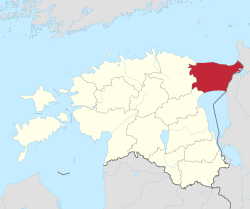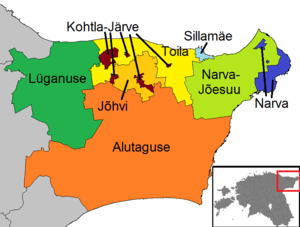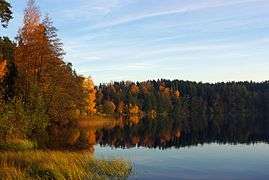Ida-Viru County
Ida-Viru County (Estonian: Ida-Viru maakond), (Russian: Ида-Вируский уезд, Ида-Вирумаа) or Ida-Virumaa, is one of 15 counties of Estonia. It is the most north-eastern part of the country. The county contains large deposits of oil shale - the main mineral mined in Estonia. As oil shale is used in thermal power plants, the earth in Ida-Viru contains most of Estonia's energy resources. The capital of the county is the town of Jõhvi which is administratively united with the Jõhvi Parish. In January 2019 Ida-Viru County had a population of 136,240 – constituting 10.3% of the total population in Estonia.[1][2] It borders Lääne-Viru County in the west, Jõgeva County in the southwest and Russia (Leningrad Oblast) in the east.
Ida-Viru County | |
|---|---|
 Flag  Coat of arms | |
 | |
| Country | Estonia |
| Capital | Jõhvi |
| Largest town | Narva |
| Area | |
| • Total | 2,972 km2 (1,147 sq mi) |
| Population (2019)[1] | |
| • Total | 136,240 |
| • Rank | 3rd |
| • Density | 46/km2 (120/sq mi) |
| Ethnicity | |
| • Russians | 73.1% |
| • Estonians | 18.9% |
| • Ukrainians | 2.3% |
| • other | 5.7% |
| ISO 3166 code | EE-44 |
| Vehicle registration | I |
History
During the latter part of the period of Soviet rule of Estonia, Ida-Virumaa was called Kohtla-Järve district, and its administrative capital was Kohtla-Järve.
County Government
County Government (Estonian: maavalitsus), led by a governor (Estonian: maavanem), ceased to exist after administrative reform in 2017. The last governor of Ida-Viru county was Andres Noormägi.[3]
Demographics
.png)
In January 2017, the population of Ida-Virumaa was 143,880, which makes it the third largest county in Estonia (after Harju and Tartu counties, which include the capital Tallinn and country's second-largest city Tartu). 44.6% of the population are men and 55.4% women.[2]
In the aftermath of World War II, Estonia was occupied by the Soviet Union and large swaths of Ida-Viru County underwent ethnic cleansing by the Soviet authorities. Estonians, who were forced out of the major population centers, including Narva, were replaced by colonists from Russia. As a result of mass migration from the Soviet Union, Ida-Viru County is now the only county in Estonia where ethnic Russians have largely replaced the indigenous Estonian population.
By ethnic origin, on 1 January 2017, 73.1% of the population were Russians, 18.9% were Estonians, 2.3% were Ukrainians, 2.1% were Belarusians and 0.9% were Finns.[2]
Municipalities
Ida-Virumaa County is subdivided into eight municipalities, of which four are urban (Estonian: linnad — cities or towns) and four are rural (Estonian: vallad — parishes). There are 217 villages in Ida-Virumaa.

| Rank | Municipality | Type | Population (2018)[4] | Area km2[4] | Density[4] |
|---|---|---|---|---|---|
| 1 | Alutaguse Parish | Rural | 4,929 | 1,465 | 3.4 |
| 2 | Jõhvi Parish | Rural | 11,645 | 124 | 93.9 |
| 3 | Kohtla-Järve | Urban | 35,395 | 39 | 907.6 |
| 4 | Lüganuse Parish | Rural | 8,942 | 599 | 14.9 |
| 5 | Narva | Urban | 58,610 | 85 | 689.5 |
| 6 | Narva-Jõesuu | Urban | 4,828 | 411 | 11.7 |
| 7 | Sillamäe | Urban | 13,406 | 11 | 1,218.7 |
| 8 | Toila Parish | Rural | 4,807 | 266 | 18.1 |
Landmarks
References
- "Population number, area and density. administrative division as at 01.01.2018". Statistics Estonia. Retrieved 6 July 2019.
- "Population by sex, ethnic nationality and County, 1 January". stat.ee. Statistics Estonia. 2010-04-19. Retrieved 2010-08-19.
- "Maavanem". Archived from the original on 15 March 2017. Retrieved 24 September 2015.
- "Elanike demograafiline jaotus maakonniti". Kohaliku omavalitsuse portaal. Archived from the original on 2 March 2019. Retrieved 2 April 2018.
External links
| Wikimedia Commons has media related to Ida-Viru County. |




